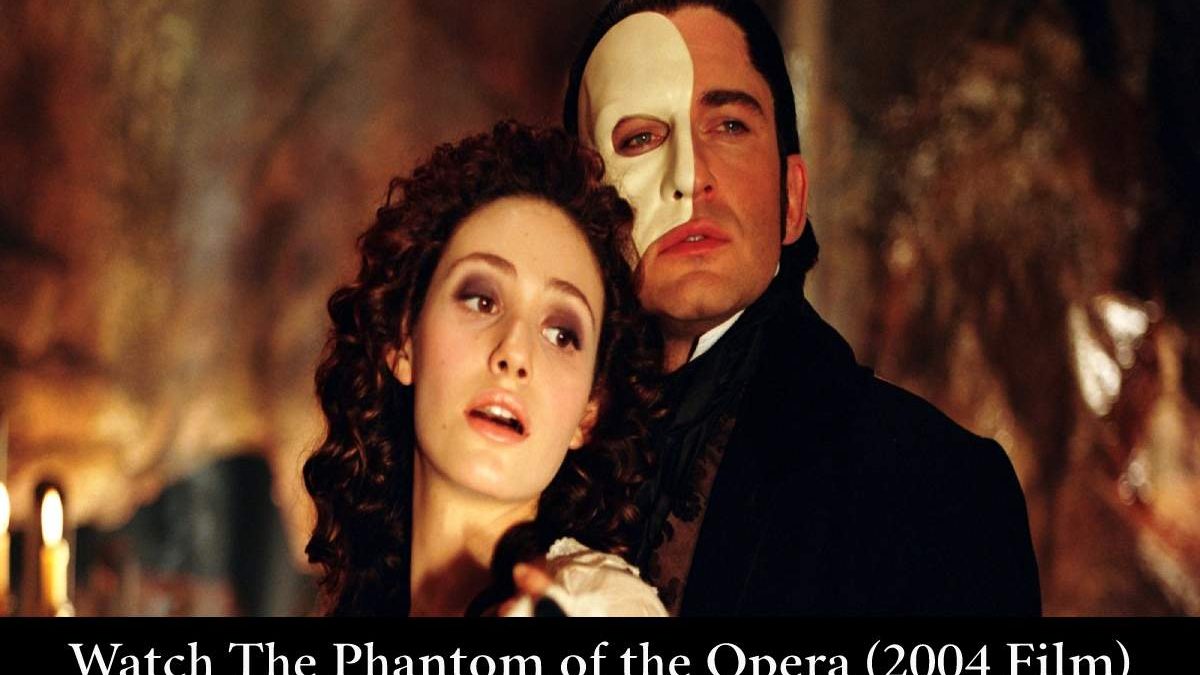Table of Contents
Introduction
Watch The Phantom of the Opera (2004 Film). In 2004, Joel Schumacher transported audiences into the mesmerizing world of Andrew Lloyd Webber’s renowned musical with the cinematic adaptation of “The Phantom of the Opera.” This introduction invites you to relive the grandeur and allure of the Paris Opera House, where love and tragedy intertwine in a hauntingly beautiful tale.
The film unfolds as a visual and auditory masterpiece, capturing the essence of the original musical while adding a cinematic dimension. From the opulent sets to the unforgettable performances, each frame is a brushstroke on a canvas of romance and mystery. Join us on a journey into the heart of this cinematic spectacle, where the Phantom’s haunting melodies echo through the corridors, and Christine and Raoul’s passion unfolds against a grand opera’s backdrop. “The Phantom of the Opera” (2004) beckons you to immerse yourself in a timeless tale of love, music, and the enigmatic allure of the masked maestro.
The Cinematic Spectacle: A Visual Symphony
In Watch The Phantom of the Opera (2004 Film), Joel Schumacher orchestrates a visual symphony that transcends the confines of the Paris Opera House. The film’s cinematography and set design intricately weave together to create a sumptuous backdrop for the unfolding drama. Each frame is a carefully composed masterpiece, capturing the grandeur of the opera scenes, the haunting beauty of the Phantom’s lair, and the romantic allure of the film’s settings.
The luxury of the visual elements elevates the cinematic experience, transporting audiences into a world where every detail is a note in the larger symphony of storytelling. The lavish production design and Schumacher’s directorial finesse transform the screen into a canvas of breathtaking visuals, immersing viewers in the enchanting and mysterious air of “The Phantom of the Opera.” The film’s visual spectacle becomes integral to its enduring charm, leaving an indelible mark on the cinematic landscape.
Musical Mastery: Bringing Broadway to the Big Screen
Watch The Phantom of the Opera (2004 Film). The film seamlessly translates Andrew Lloyd Webber’s Broadway musical brilliance into a cinematic masterpiece. The musical mastery is evident in the film’s exquisite soundtrack. Featuring the powerful vocals of Gerard Butler as the Phantom and Emmy Rossum as Christine. The adaptation preserves the original score’s emotional depth and soaring melodies while adding a cinematic dimension. This transition from stage to screen demonstrates a harmonious fusion of musical elements. Ensuring that the film becomes a symphony of emotion that resonates with both devoted fans of the musical and newcomers alike.
The Enigmatic Characters: Phantom, Christine, and Raoul
Central to Watch The Phantom of the Opera (2004 Film) are the enigmatic characters that breathe life into this timeless tale. Gerard Butler’s portrayal of the Phantom brings a nuanced blend of darkness and vulnerability, creating a haunting and empathetic character. Emmy Rossum embodies Christine’s innocence and passion. While Patrick Wilson’s Raoul adds a layer of chivalry to the captivating love triangle. The dynamic performances elevate these characters beyond their archetypes. Immersing the audience in the complexities of their relationships and adding depth to the narrative canvas. Each character’s journey becomes a poignant exploration of love, sacrifice, and redemption.
Behind the Mask: Exploring Themes of Love and Isolation
“The Phantom of the Opera” explores profound themes of love, isolation, and societal judgment. The Phantom’s disfigurement becomes a metaphor for societal prejudices, and his yearning for love unfolds as a poignant journey. Christine’s internal conflict, torn between societal expectations and her heart’s desires, adds depth to the narrative. The film becomes a canvas for exploring the human condition’s complexities.
Cinematic Impact and Legacy
Examining the film’s impact, we trace its journey from Broadway adaptation to cinematic spectacle. Watch The Phantom of the Opera (2004 Film) has left an enduring legacy. Influencing subsequent film adaptations of musicals and solidifying its place in cinematic history. The article explores how the film has continued to captivate audiences & inspire a new generation of fans.
Critical Reception and Awards
While celebrated for its visual opulence and musical prowess, the film also faced critiques. Analyzing its reception provides insight into the challenges of adapting a beloved musical for the screen. Additionally, exploring the accolades and recognitions received sheds light on the film’s cultural significance and industry acclaim.
Fanbase and Cultural Influence
“The Phantom of the Opera” has cultivated a dedicated fanbase that spans the globe. The article examines the cultural influence of the film. From fan communities and theatrical adaptations to its impact on popular culture. The story’s enduring appeal speaks to its universal themes that resonate across diverse audiences.
Conclusion
In conclusion, Watch The Phantom of the Opera (2004 Film) transcends its genre, emerging as a cinematic masterpiece that marries music, visuals, and storytelling. Joel Schumacher’s directorial vision, with outstanding performances and Andrew Lloyd Webber’s iconic score, crafts a timeless ode to love, passion, and the enduring power of art. As audiences continue to be enraptured by the film’s magic. “The Phantom of the Opera” stands as an everlasting testament to the enchantment of the silver screen.

